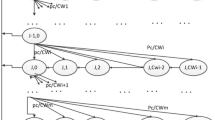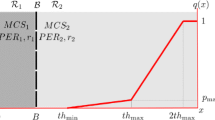Abstract
In this paper, a novel queuing analytical framework is introduced to analyze the performance of the HCF controlled channel access designed as a medium access mechanism in wireless local area networks. The queuing model defines a multi-rate medium using adaptive modulation and coding which is a key point in wireless networks to increase effective transmission rate. Based on a MAP (Markovian arrival process)/PH (phase type)/1 queue with vacation and time-limited service, the model considers a limited node buffer and non-ideal channel with the automatic repeat request protocol. Using a MAP for traffic arrival process and PH distribution for packet service process, the inclusion of the non-transmission and vacation processes makes our analysis very general and comprehensive to support various types of practical traffic streams. To formulate the model, the powerful matrix-geometric method is employed, and the mutual impacts of some parameters in the MAC and the PHY layers are then evaluated to improve system performance. Finally, optimization of parameter settings to maximize throughput is discussed.
Similar content being viewed by others
References
Chung T. S., Goldsmith J. A. (2001) Degree of freedom in adaptive modulation: a unified view. IEEE Transaction on Communications 49: 1561–1571
Liu Q., Zhou S., Giannakis B. G. (2005) Queuing with adaptive modulation and coding over wireless link: cross-layer analysis and design. IEEE Transactions on wireless Communications 4(3): 1–11
IEEE 802.11e/D13.0, Part 11. (2005). Wireless LAN medium access control (MAC) and physical layer (PHY) specifications: medium access control (MAC) enhancements or quality of service (QoS). Draft supp. to IEEE 802.11std.
Malkamaki E., Leib H. (2000) Performance of truncated type-II hybrid ARQ schemes with noisy feedback over blocking fading channels. IEEE Transactions Communications 48: 1477–1487
Alouini S. M., Goldsmith J. A. (2000) Adaptive modulation over Nakagami fading channels. kluwer J. Wireless Communications 13(1–2): 119–143
Holm J. K., Oien E. G. (2000) Adaptive multidimensional coded modulation over flat fading channels. IEEE Journal of Selection Areas Communications 18: 1153–1158
Liu Q., Zhou S., Giaannakis B. G. (2004) Cross-layer combining of adaptive modulation and coding with truncated ARQ over wireless links. IEEE Transactions Communications 3: 1746–1754
Fantacci R., Zoppi L. (2000) Performance evaluation of polling systems for wireless local communication networks. IEEE Transsactions on Vehicular Technology 49: 2148–2157
Le, B. L., Hossain, E., Alfa, S. A. (2004). Queuing analysis for radio link level scheduling in a multi-rate TDMA wireless networks. IEEE Communications Society. 4061–4065.
Le B. L., Hossain E., Alfa S. A. (2005) Queuing analysis and admission control for multi-rate wireless networks with opportunistic scheduling and ARQ-based error control. IEEE International Conference on Communications 5: 3329–3333
Rashid M. M., Hossain E., Bhargava V. K. (2008) Controlled channel access scheduling for guaranteed QoS in 802.11e-based WLANs. IEEE Transactions Wireless Communications 7(4): 1287–1297
Ghazizadeh R., Fan P. (2009) A priority queuing model for HCF controlled channel access (HCCA) in wireless LANs. International Journal of Communications, Network System Sciences 2(1): 30–43
Ghazizadeh, R., & Fan, P. (2008). Queuing analysis for HCCA with adaptive modulation coding over wireless LANs. IEEE International Conference on Communications Systems. 885–889.
Proakis, G. J. (2000). Digital Communications. 4th ed, MacGraw-Hill.
Wang S. H., Moayeri N. (1995) Finite state Markov channel—a useful model for radio communication channels. IEEE Transactions Vehicles Technology 44(1): 163–171
Zhang Q., Kassam A. S. (1999) Finite-state Markov model for Rayleigh fading channels. IEEE Transactions Communications 7(11): 1688–1692
Blondia, C., & Casals, O. (1992). Performance analysis of statistical multiplication of VBR sources. Conf. IEEE Computer Communications Societies. 828–838.
Neuts F. M. (1981) Matrix Geometric Solutions in Stochastic Models—An Algorithmic Approach. John Hopkins University Press, Baltimore, MD
Author information
Authors and Affiliations
Corresponding author
Rights and permissions
About this article
Cite this article
Ghazizadeh, R., Fan, P. Queuing Analysis of HCCA for Multi-Rate Wireless LANs with Truncated ARQ Protocol. Wireless Pers Commun 55, 607–630 (2010). https://doi.org/10.1007/s11277-009-9822-0
Published:
Issue Date:
DOI: https://doi.org/10.1007/s11277-009-9822-0




